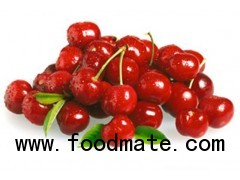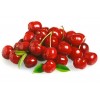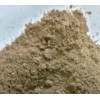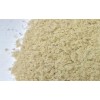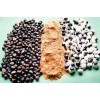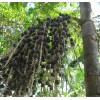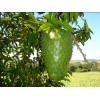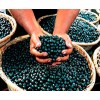1 - Acerola Dry Extract 6% Vitamin ´C´
Packing: 25kg fiber barrel
Family: Malpighiaceae
Genus: Malpighia
Species: glabra
Synonyms: Malpighia biflora, M. fallax, M. lucida, M. neumanniana, M. nitida, M. peruviana, M. punicifolia, M. semeruco, M. undulata, M. uniflora
Common names: Acerola, Antilles cherry, Barbados cherry, cereso, cerezo, escobillo, health tree, huesito, Puerto Rican cherry, West Indian cherry
Part Used: Fruit, leaves
HERBAL PROPERTIES AND ACTIONS
Main Actions
• is nutritious
• kills fungi
Other Actions
• fights free radicals
• dries secretions
• increases urination
Standard Dosage
Fruit
Fresh Juice: 1 cup 2-3 times daily
Tablets: 1-2 g twice daily
Acerola (Malphighia glabra) is a small tree or shrub that grows up to 5 m high in the dry, deciduous forest. It produces an abundance of bright red fruit 1-2 cm in diameter, with several small seeds that look similar to the European cherry. For this reason, acerola is also known as the Antilles, Barbados, Puerto Rican, or West Indian cherry tree. The mature fruits are juicy and soft with a pleasant, tart flavor. Acerola can be found growing wild and under cultivation on the sandy soils throughout northeastern Brazil. It is native to northern South America, Central America, and Jamaica. Its cousin, M. punicifolia, is present as far north as Florida and Texas.
TRIBAL AND HERBAL MEDICINE USES
Acerola juice is as common and popular in Brazil as orange juice is in North America. As a natural remedy in Brazil, a handful of fresh fruit is eaten for fever and dysentery. It is also used there as an anti-inflammatory, astringent, stimulant for the liver and renal systems, diuretic, and to support heart function as well as to heal wounds. It is employed as a nutritive aid for anemia, diabetes, high cholesterol levels, liver problems, rheumatism, tuberculosis, and during convalescence.
In North America, the use of acerola is mostly based on its high content of vitamin C, which has long been thought in conventional and alternative health practices as a powerful antioxidant.
Acerola Benefits
Acerola (Malpighia emarginata) is a significant source of vitamin C in the natural form of ascorbic acid, containing as much as 1000 to 4500 milligrams per 100 grams of edible fruit. Vitamin C is an essential dietary nutrient, playing a role in immune system health. It is also important in the synthesis of collagen, a structural component of bone, skin and blood vessels as well as the synthesis of brain chemicals involved in mood regulation. Vitamin C content is highest in the less ripened fruit and after harvest the percent of vitamin C can be preserved by freezing the plant.
Vitamin A is another important nutrient found in the acerola, yielding as much as a bundle of full-sized carrots, or approximately 3400 to 12,500 international units per 100 grams of fruit. Vitamin A plays a role in visual health, normal growth and ongoing development, red blood cell production and it protects the immune system.
Additional micronutrients found to a lesser degree in the fruit include several B-vitamins, calcium, iron, potassium and magnesium. Each of which is necessary in a normal diet. Protein, fiber and fatty acids, important macronutrients of the diet, are also in the fruit.
Acerola is also known as: Barbados cherry, West Indian cherry and Cereza. It has its origins in the Yucatan and is widely distributed throughout the hotter southern climates of the United States like Florida and Texas, as well as the Central and the northern part of South America. The plant is also cultivated throughout the Caribbean and sub-tropical regions. As of current, Brazil is the largest mass cultivar of the plant.
Acerola is a small tree or bushy shrub that grows best in tropical type climates and has poor cold tolerance because of its shallow root systems. Its leaves are a glossy lush green that varies between light and dark hues and the flowering portion of the plan blossoms five small pink to white petals. The actual fruit of the plant, which is used in the manufacture of supplements, is a bright red or yellow-orange, cherry sized lobe containing small seeds. The pulp of the fruit offers a delicately sweet aroma and taste but is acidic.
Once the fruit is harvested from the plant it must be used or converted into its supplemental form quickly because deterioration is rapid. Within three to five days the picked fruit ferments and becomes unsavory, develops mold and loses its healthful properties.
Historically, the natural form of the fruit was harvested and used to treat a host of ailments including diarrhea or inflammation of the intestines. However, it is popular as an alternative supplement to ease symptoms of the common cold, mainly because of its high vitamin C content. Supplements are also touted as energy boosters for athletic endurance, as a means for minimizing symptoms of depression and to relieve infections of the gum and tooth.
Acerola supplements are available as powder extract to be mixed into water, fruit or vegetable juices. Topical cream formulations also exist for direct skin application to enhance elasticity and collagen production or for use as an antifungal remedy. No standard dosing exists for acerola supplements as dosing is dependent upon several variables including age, current health and pre-existing conditions. Common dosing is one level teaspoon, or 3.6 grams, of powder mixed with an 8-ounce beverage and taken three to five times a week. Some manufacturers might also market acerola in oral capsule form as vitamin C. Review package labeling for proper instruction.
Clinical evidence suggests that the high antioxidant properties, which comes from the vitamins A and C, of acerola might serve as a significant element in the regular diet, as evidenced by several published research studies. Research is ongoing to determine its exact benefits and potential long term adverse effects.


